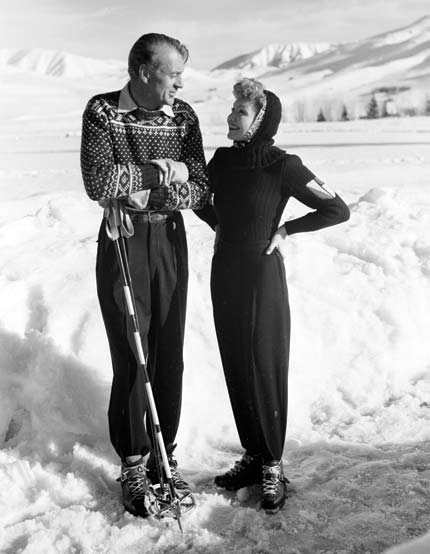
65 YEARS AGO
PROPOSAL TO SEGREGATE SKIERS BY SKILL. Keep the experts off the novice trails, or make them ski at the pace of a novice, enabling genuine novices to relax and enjoy themselves. Make the schussboomer stop booming on trails not meant for high-speed skiing. On expert and fast intermediate trails, on the other hand, impose a minimum speed limit so that novices are reluctant to leave the safe, slow trail for one that’s too much for them. To enforce, deputize patrollers and responsible skiers, providing them with whistles and armbands. – James L. Potter, January 15, 1949 SKI Magazine.
WHEN SKI INJURY WAS FRACTURE OR SPRAIN. Of 4,428 injuries reported last season to the National Ski Patrol, 48 percent were sprains and 23 percent were fractures, according to Minot Dole. Of the fractures, 56 percent were of the ankle, 28 percent of the lower leg and other parts of the anatomy. -- February 1, 1949 SKI Magazine.
HOLLYWOOD INVADES ASPEN. The Gary Coopers of Hollywood have purchased 30 acres of land in Aspen, and plan to build in the Spring. – February 15, 1949 SKI Magazine.
55 YEARS AGO
THE ONE-SKI RULE. Until shortly after World War II a racer was permitted to use only one pair of skis in an alpine combined competition. Today’s young competitors take it for granted that they need special skis for slalom, downhill and even giant slalom. This is a most discouraging state of affairs, and undemocratic. In junior races, the “rich boy” with a pair of downhill skis has a much better chance of winning than a skillful but less fortunate rival who can afford only one pair of skis for all events. – January 1959 SKI Magazine editorial.
SHAKESPEARE ON SKIING. To ski or not to ski. That is the question.
Whether ‘tis nobler in the mind to suffer broken legs and exhaustion.
Or take arms against the cold and snow, and by sitting at the bar, end them. -- Eleanor Prager, January 1959 SKI Magazine.
40 YEARS AGO
FIRST AMERICAN WINNER OF HAHNENKAMM COMBINED. With the third fastest time on the world’s most challenging downhill course, the Streif, and after placing 23rd in the slalom, Vermont’s Bob Cochran became the first American to win the Hahnenkamm Combined title at Kitzbuehel, Austria. Rolland Collombin, 22, beat fellow Swiss Bernhard Russi to win the downhill. Despite the fast course conditions, Collombin fell short of matching Jean-Claude Killy’s course record of 2:11.9 minutes set six years earlier in 1967. It was not a good year at the Hahnenkamm for host nation Austria, as France’s Jean-Noel Augert won the slalom. Held January 27-28, 1973, it was the thirty-third running of the Hahnenkamm event. – Hahnenkamm, The Chronicle of a Myth, published by the Kitzbuehel Ski Club (2003).
25 YEARS AGO
REAR-ENTRY BOOT ERRANT FORECAST. Three-quarters of all alpine ski boots sold in the U.S. are rear-entry models. With only one or two buckles, they are good-looking and easier to get in and out of than front-entry boots with four and five buckles. With a better fit, rear-entry boots will continue to be the boots of choice for most American skiers. – Bill Tanler, February 1989, Snow Country Magazine.
DOUBT ON SIA AND NSAA MERGER. The boards of directors of Ski Industries America and the National Ski Areas Association agreed to merge, aiming to market the sport through a strategy conceived by management consultant McKinsey. “When you merge two successful associations, with no overlap of memberships, each with its own priorities and agendas, you may be sowing the seeds of its dissolution even as you hammer together its mismatched parts.” – David Rowan, May 1989, Ski Area Management Magazine. (Ed note: The merger lasted only three years.)
15 YEARS AGO
SKI RESORT DEVELOPMENT CONTROL. Too many ski areas have been developed by outsiders who seek the fast buck, and have no sense of the local community’s long-term sustainability. Many of America’s ski towns would have been better off if (they) had not been seduced into unlimited development where most of the profit goes to outsiders. – Richard D. Lamm, former Governor of Colorado, January 1989, Snow Country Magazine.
HALL OF FAME, MAVERICKS DON’T MIX. The selection process for the U.S. Ski Hall of Fame “does not especially favor loners or gnarly, self-centered individualists without a large circle of friends. Yet these are the kind of characters who have often shaped the sport.” -- Morten Lund, September 1999, SKI Magazine.
Category:
Snapshots
